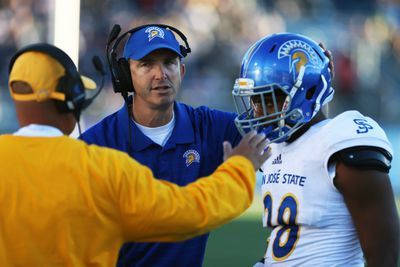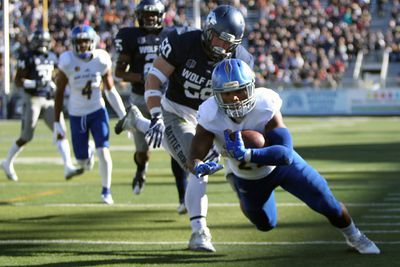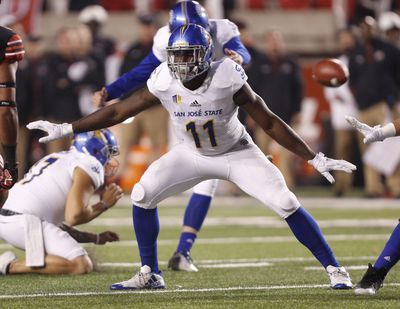#Korey Mariboho
Text
The latest San Jose State rebuild continues

Brent Brennan’s first season as the Spartans’ head coach saw a youth movement on offense. Now comes one on defense.
Right after he had left to take the Colorado head coaching job in early-2013, I spoke to former San Jose State head coach Mike MacIntyre for my first book, Study Hall. He had just pulled off a spectacular turnaround, inheriting a 2-10 squad from Dick Tomey, going 1-12 in his first season, and going 11-2 just two years later.
MacIntyre summed up everything that is both promising and difficult about the SJSU job. “I realized there were only seven [FBS] schools in California,” he said. “I felt like the supply and demand of getting players was extremely good.”
On the other hand, this isn’t a school with a massive endowment or mountains of television revenue. “We didn’t have a lot of money,” he said. “We had to go raise money. The QB club raised us $25,000 so we could go recruit in May.”
When MacIntyre had the right mix of chip-on-shoulder kids and just enough financial commitment, the program took off, finishing 26th in S&P+ in 2012.
Within two years, they were 3-9 again. After eking out a bowl bid in 2015, they were 2-11 two years later. Such is life in San Jose.
Jack Elway went 9-3 with a California Bowl bid in 9-3. Two years later, he was 5-6.
Claude Gilbert took the Spartans from 2-8-1 in 1985 to 10-2 in both 1986 and 1987 ... and 4-8 in 1988.
Terry Shea went 9-2-1 in 1990, and within three years (and two coaching changes), the team went 2-9.
Dick Tomey went 9-4 in 2006 and 2-10 in 2009.
Making the upgrade to the Mountain West in 2013 has can only mean even higher highs and lower lows.
A SJSU roster tends to be a chemistry experiment of overlooked local prospects, high-upside athletes with red flags (either of the character or academic variety), and wayward JUCOs. When the chemistry is right, SJSU athletes can do serious damage. The Spartans have beaten Stanford 14 times, Arizona State 11 times, and Cal six times.
But it’s easy to get the chemistry wrong. Maybe the overlooked guys are overlooked for a reason. Maybe the red-flag guys never make it to campus.
This is a long way of saying Brennan’s first year didn’t go well, and that was understandable. His predecessor, Ron Caragher, signed an incredible top-60 class in 2015, but almost none of the top members of that class were still around two years later. He ended up gambling on youth in key positions — offensive coordinator and quarterback, to name two — and it didn’t even slightly pay off.
Worse, this wasn’t a total youth movement. SJSU had quite a few upperclassmen on the offensive line, linebacking corps, and secondary. Those units are facing a rebuild this year, and Brennan’s already on Offensive Coordinator No. 2.
If you’re looking for hope, remember P.J. Fleck’s first year at WMU. I wrote last year that in Brennan, SJSU was hoping it had found its own Fleck, a charismatic recruiter and chemistry builder who could overcome experience — aside from one year as SJSU offensive co-coordinator in 2009, Brennan had never been more than a receivers coach and recruiting coordinator at the FBS level — with boundless enthusiasm.
Fleck’s first year at WMU was a disastrous 1-11. The turnaround, however, began the very next year.

Lance Iversen-USA TODAY Sports
Brent Brennan
Offense

We’ll start with the good news: from a pure recruiting standpoint, there is talent on offense. Per the 247Sports Composite, quarterback Montel Aaron, top running backs Tyler Nevens and Malike Roberson, and five of the top eight returning receivers were all three-star prospects (including mid-three stars JaQuan Blackwell and Justin Holmes). The offensive line, rebuilding as it may be, could end up centering around a trio of mid-three-stars, as well, in junior Dominic Fredrickson, JUCO transfer Korey Mariboho, and freshman Max Barth.
As SJSU fans know quite well, simply landing three-star guys is only step one. You’ve got to actually develop them, too. That’s now up to new coordinator Kevin McGiven, who worked with Brennan at Oregon State and has had OC stints at Southern Utah, Weber State, Montana State, Utah State, and Oregon State. That’s quite the collection of polos.
McGiven’s timing hasn’t been great. Both of his years at USU coincided with a swath of quarterback injuries, and he took over the OSU offense just in time for the entire team to fall apart under Gary Andersen. Oh yeah, and again his starting QB got hurt.
Oregon State had no explosiveness whatsoever, but McGiven was able to carve out occasional efficiency with a foursome of running backs combining for 28 carries per game and a foursome of receivers catching between 30 and 34 (mostly short) passes.
McGiven likes spreading the ball around, and he’s got a potentially deep skill corps. Nevens was a pretty efficient back for a true freshman, producing a marginal efficiency rate of plus-2.2 percent, and Roberson flashed at least a little bit of explosiveness in rare open-field opportunities. The receiving corps returns last year’s top six targets, all of whom caught between 22 and 37 balls.

Lance Iversen-USA TODAY Sports
Tyler Nevens
Variety is good, but having actual play-makers is better. Does SJSU? Senior receiver Tre Hartley did average 14.2 yards per catch, and both he and fellow senior Justin Holmes produced marginal explosiveness rates of plus-0.25 points per successful play or higher. That pretty good. But they also combined for just a 52 percent catch rate. Hartley was SJSU’s leading receiver, and his catch rate was just 49 percent.
All-or-nothing weapons need solid possession guys as complements, which means guys like tight end Josh Oliver and sophomore slots Blackwell and Tre Walker probably need to carry more of a load.
Blackwell, a former star recruit, certainly had his moments in his redshirt freshman campaign: four catches for 84 yards against Poly, four for 70 against Utah, receptions of 48 and 35 yards, plus a 23-yard hook and lateral, against Hawaii. Walker picked up steam as the year progressed, too, catching eight for 104 against UNLV and making 24 of his 26 receptions in the last eight games. They could be the keys to unlocking more downfield potential from guys like Hartley and Holmes.

Photo by George Frey/Getty Images
JaQuan Blackwell
Aaron appeared to show some potential before getting sucked into the undertow of a terrible season. Despite missing three games in the middle of the year, he had three or four solid games. And then November struck.
Aaron’s first 6 games: 60% completion rate, 12.5 yards per completion, 8 TD, 3 INT, 139.0 passer rating
Aaron’s last 4 games: 51% completion rate, 11.6 yards per completion, 0 TD, 7 INT, 87.8 passer rating
We’ll chalk that up to the combination of not having enough experience and not getting enough help. But the 6’5 sophomore does appear to have a pretty high ceiling.
Of course, nothing opens up downfield opportunities like a good run game. It’s hard to feel too optimistic about that aspect. SJSU ranked 125th in rushing success rate last year, and the biggest relative strength, avoiding negative plays (77th in stuff rate), could take a hit with the loss of four linemen who combined for 43 of last year’s starts.
Left tackle Troy Kowalski’s back, and sophomore Jack Snyder got his feet wet, but unless the aforementioned star recruits (Fredrickson, Mariboho, Barth) are ready to play close to their ceiling, it’s hard to imagine the run game getting much better.
Defense

Derrick Odum also got to know Brennan at Oregon State, and he technically had more success than his offensive counterparts. But as the chart above so harshly reminds us, it wasn’t that much success. The Spartans were pretty good at big-play prevention ... and that’s about it. They were a little too bendy to qualify as a bend-don’t-break unit, ranking 117th in rushing success rate and 106th in passing success rate.
SJSU seemed to have decent plans and no depth to accomplish them. The Spartans were 91st in Q1 S&P+, 85th in Q3, and 82nd on first downs. Those other splits? 122nd in Q2, 100th in Q4, 115th on second down, 109th on third down. They couldn’t sustain success, and having an up-tempo offense going three-and-out very quickly probably didn’t help.
They could have better depth on the line, at least. Odum basically played only three guys up front — ends Bryson Bridges and Sailosi Latu and tackle Owen Roberts, all of whom return in 2018; despite the fact that these three guys combined to miss five games, however, SJSU still didn’t have another lineman who recorded more than 7.5 tackles or played in more than nine games.
In theory, that depth could increase this year, with three-star sophomores like tackle Kyle Hoppe and end Cameron Alexander having a little more experience under their respective belts.
It was the same story at linebacker: four starters recorded 28.5 or more tackles, and only one backup recorded more than six. But of those top five guys, only two return. Senior Jamal Scott was a keeper, recording 10 tackles for loss, but sophomore Tysyn Parker is the only even slightly known entity. And while recruiting has been solid elsewhere, the only other former three-star recruits in the chamber, besides Parker, are true freshmen.

Photo by Ethan Miller/Getty Images
Jamal Scott
Odum opened the umbrella a bit more in the back. Nine players recorded at least 21 tackles last season, and a 10th, safety Chad Miller, did so in 2016 before missing last season after getting stabbed in May.
That makes the thought of losing three starters a little less daunting. Safety Maurice McKnight and corner Jermaine Kelly were the stars of the unit, but in players like nickel Ethan Aguayo (3.5 TFLs), safety Trevon Bierria (two TFLs, eight passes defensed), and corner Dakari Monroe (3.5 TFLs, six passes defensed), there are far more known play-makers in the back of the defense than in the front.
Of course, pass defense only matters if you can force opponents to pass. Between an iffy run defense and the fact that SJSU’s offense wasn’t much of a threat, opponents ran and ran and ran on the Spartans last year — 71 percent of the time on standard downs (second-most in the country) and 37 percent on passing downs (45th). It’s up to the defensive line (and the offense, I guess), to force opponents to the air.

D. Ross Cameron-USA TODAY Sports
Dakari Monroe
Special Teams
SJSU totally wasted a great special teams unit. The Spartans ranked second in the country in FG efficiency, with Bryce Crawford making seven of 10 field goals outside of 40 yards and seven of seven inside. (For variety’s sake, he also missed four PATs somehow.) Punter Michael Carrizosa, meanwhile, averaged 45.6 yards per kick.
Carrizosa is gone, but at least Crawford returns. He averaged 41.6 yards over seven punts against CSU, so perhaps the legs will still be a strength.
2018 outlook
2018 Schedule & Projection Factors
Date Opponent Proj. S&P+ Rk Proj. Margin Win Probability 30-Aug UC Davis NR 3.0 57% 8-Sep at Washington State 41 -27.0 6% 15-Sep at Oregon 23 -32.9 3% 29-Sep Hawaii 122 -2.4 45% 6-Oct Colorado State 95 -10.6 27% 13-Oct Army 92 -11.3 26% 20-Oct at San Diego State 55 -24.2 8% 27-Oct UNLV 105 -8.2 32% 3-Nov at Wyoming 72 -20.9 11% 10-Nov at Utah State 77 -20.5 12% 17-Nov Nevada 101 -8.9 30% 24-Nov at Fresno State 44 -26.5 6%
Projected S&P+ Rk 129 Proj. Off. / Def. Rk 118 / 124 Projected wins 2.6 Five-Year S&P+ Rk -9.5 (112) 2- and 5-Year Recruiting Rk 108 / 85 2017 TO Margin / Adj. TO Margin* -26 / -15.2 2017 TO Luck/Game -4.1 Returning Production (Off. / Def.) 69% (85%, 52%) 2017 Second-order wins (difference) 2.1 (-0.1)
There are just enough exciting sophomores to talk yourself into the Spartans improving on offense, and there are just enough play-makers in the secondary, and experienced pieces on the line, to talk yourself into SJSU holding steady on defense.
There are also just enough holes to talk yourself right back out.
Sometimes a team takes off in its second year under a new coach, and we often don’t know in advance. But it’s hard to feel too good about it happening in San Jose. S&P+ projects the Spartans 129th in FBS this year, with a 12 percent win probability or worse in six of 12 games and a greater than 32 percent chance in just two (45 percent against Hawaii, 57 percent against UC Davis). Yikes.
Low lows are not a new thing for San Jose State. The best hope for 2018 is that we’ll at least learn if there is potential for some high highs.
Team preview stats
All power conference preview data to date.
0 notes